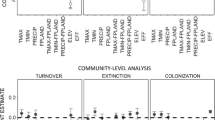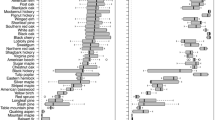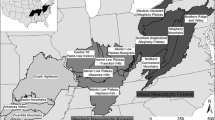Abstract
Context
Global temperatures are projected to increase and affect forests and wildlife populations. Forest management can potentially mitigate climate-induced changes through promoting carbon sequestration, forest resilience, and facilitated change.
Objectives
We modeled direct and indirect effects of climate change on avian abundance through changes in forest landscapes and assessed impacts on bird abundances of forest management strategies designed to mitigate climate change effects.
Methods
We coupled a Bayesian hierarchical model with a spatially explicit landscape simulation model (LANDIS PRO) to predict avian relative abundance. We considered multiple climate scenarios and forest management scenarios focused on carbon sequestration, forest resilience, and facilitated change over 100 years.
Results
Management had a greater impact on avian abundance (almost 50% change under some scenarios) than climate (<3% change) and only early successional and coniferous forest showed significant change in percent cover across time. The northern bobwhite was the only species that changed in abundance due to climate-induced changes in vegetation. Northern bobwhite, prairie warbler, and blue-winged warbler generally increased in response to warming temperatures but prairie warbler exhibited a non-linear response and began to decline as summer maximum temperatures exceeded 36 °C at the end of the century.
Conclusion
Linking empirical models with process-based landscape change models can be an effective way to predict climate change and management impacts on wildlife, but time frames greater than 100 years may be required to see climate related effects. We suggest that future research carefully consider species-specific effects and interactions between management and climate.





Similar content being viewed by others

References
Albright TP, Pidgeon AM, Rittenhouse CD, Clayton MK, Wardlow BD, Flather CH, Culbert PD, Radeloff VC (2010) Combined effects of heat waves and droughts on avian communities across the conterminous United States. Ecosphere 1:1–22. doi:10.1890/ES10-00057.1
Albright TP, Pidgeon AM, Rittenhouse CD, Clayton MK, Flather CH, Culbert PD, Radeloff VC (2011) Heat waves measured with MODIS land surface temperature data predict changes in avian community structure. Remote Sens Environ 115:245–254. doi:10.1016/j.rse.2010.08.024
Araújo MB, Peterson AT (2012) Uses and misuses of bioclimatic envelope modeling. Ecology 93:1527–1539
Auer SK, Martin TE (2013) Climate change has indirect effects on resource use and overlap among coexisting bird species with negative consequences for their reproductive success. Glob Chang Biol 19:411–419
Benítez-López A, Alkemade R, Verweij PA (2010) The impacts of roads and other infrastructure on mammal and bird populations: a meta-analysis. Biol Conserv 143:1307–1316
Blizzard EM, Kabrick JM, Dey DC, Larsen DR, Pallardy SG, Gwaze DP (2013) Light, canopy closure, and overstory retention in upland Ozark forests. In: Guldin, James M (eds) Proceedings of the 15th biennial southern silvicultural research conference. e-Gen. Tech. Rep. SRS-GTR-175. U.S. Department of Agriculture, Asheville
Bolger DT, Patten MA, Bostock DC (2005) Avian reproductive failure in response to an extreme climatic event. Oecologia 142:398–406
Bonnot TW, Thompson FR III, Millspaugh JJ, Jones-Farrand DT (2013) Landscape-based population viability models demonstrate importance of strategic conservation planning for birds. Biol Conserv 165:104–114
Brandt L, He H, Iverson L, Thompson FR III, Butler P, Handler S, Janowiak M, Shannon PD, Swanston C, Albrecht M, Blume-Weaver R, Deizman P, DePuy J, Dijak WD, Dinkel G, Fei S, Jones-Farrand DT, Leahy M, Matthews S, Nelson P, Oberle B, Perez J, Peters M, Prasad A, Schneiderman JE, Shuey J. Smith AB, Studyvin C, Tirpak JM, Walk JW, Wang WJ, Watts L, Weigel D, Westin S (2014) Central Hardwoods ecosystem vulnerability assessment and synthesis: a report from the Central Hardwoods Climate Change Response Framework Project. Gen. Tech. Rep. NRS-124. U.S. Department of Agriculture, Forest Service, Newtown Square
Chapman S, Mustin K, Renwick AR, Segan DB, Hole DG, Pearson RG, Watson JEM (2014) Publishing trends on climate change vulnerability in the conservation literature reveal a predominant focus on direct impacts and long time-scales. Divers Distrib 20:1221–1228
D’Amato AW, Bradford JB, Fraver S, Palik BJ (2011) Forest management for mitigation and adaptation to climate change: insights from long-term silviculture experiments. For Ecol Manag 262:803–816
Dale VH, Joyce LA, McNulty S, Neilson RP (2000) The interplay between climate change, forests, and disturbances. Sci Total Environ 262:201–204
Dijak WD (2013) Landscape Builder: software for the creation of initial landscapes for LANDIS from FIA data. Comput Ecol Softw 3:17–25
Evans AM, Perschel R (2009) A review of forestry mitigation and adaptation strategies in the Northeast U.S. Clim Chang 96:167–183
Ferger SW, Schleuning M, Hemp A, Howell KM, Böhning-Gaese K (2014) Food resources and vegetation structure mediate climatic effects on species richness of birds. Glob Ecol Biogeogr 23:541–549
Galatowitsch S, Frelich L, Phillips-Mao L (2009) Regional climate change adaptation strategies for biodiversity conservation in a midcontinental region of North America. Biol Conserv 142:2012–2022
Gill FB, Canterbury RA, Confer JL (2001) Blue-winged warbler (Vermivora pinus). In: Poole A (ed) The birds of North America online. Cornell Lab of Ornithology, Ithaca. Retrieved from the birds of North America Online http://bna.birds.cornell.edu/bna/species/584
Gingrich SF (1967) Measuring and evaluating stocking and stand density in upland hardwood forest in the Central States. For Sci 13:38–53
Goetz SJ, Steinberg D, Betts MG, Holmes RT, Doran PJ, Dubayah R, Hofton M (2010) Lidar remote sensing variables predict breeding habitat of a Neotropical migrant bird. Ecology 91:1569–1576
Grimm NB, Chapin FS, Bierwagen B, Gonzalez P, Groffman PM, Luo Y, Melton F, Nadelhoffer K, Pairis A, Raymond PA, Schimel J, Williamson CE (2013a) The impacts of climate change on ecosystem structure and function. Front Ecol Environ 11:474–482
Grimm NB, Staudinger MD, Staudt A, Carter SL, Chapin FS, Kareiva P, Ruckelshaus M, Stein BA (2013b) Climate-change impacts on ecological systems: introduction to a US assessment. Front Ecol Environ 11:456–464
Hamilton CM, Martinuzzi S, Plantinga AJ, Radeloff VC, Lewis DJ, Thogmartin WE, Heglund PJ, Pidgeon AM (2013) Current and future land use around a nationwide protected area network. PLoS ONE 8:e55737
He HS (2008) Forest landscape models: definitions, characterization, and classification. For Ecol Manag 254:484–498
He HS, Mladenoff DJ, Crow TR (1999) Linking an ecosystem model and a landscape model to study forest species response to climate warming. Ecol Model 114:213–233
Hitch AT, Leberg PL (2007) Breeding distributions of North American bird species moving north as a result of climate change. Conserv Biol 21:534–539
IPCC (2007) Climate change 2007: Synthesis Report. In: Core Writing Team, Pachauri, RK, Reisinger A (eds) Contribution of Working Groups I, II and III to the Fourth Assessment Report of the Intergovernmental Panel on Climate, IPCC, Geneva
Iverson LR, Prasad AM, Matthews SN, Peters M (2008) Estimating potential habitat for 134 eastern US tree species under six climate scenarios. For Ecol Manag 254:390–406
Iverson LR, Prasad AM, Matthews SN, Peters MP (2011) Lessons learned while integrating habitat, dispersal, disturbance, and life-history traits into species habitat models under climate change. Ecosystems 14:1005–1020
Iverson LR, Prasad AM, Schwartz MW (2005) Predicting potential changes in suitable habitat and distribution by 2100 for tree species of the Eastern United States. J Agic Meteorol 61:29–37
Janowiak MK, Swanston CW, Nagel LM, Brandt LA, Butler PR, Handler SD, Shannon PD, Iverson LR, Matthews SN, Prasad A, Peters MP (2014) A practical approach for translating climate change adaptation principles into forest management actions. J For 112:424–433
Johnson PS, Shifley SR, Rogers R (2009) The ecology and silviculture of oaks, 2nd edn. CABI Publishing, New York, p 580
Karstensen KA (2010) Land-cover change in the Ozark Highlands, 1973–2000: U.S. Geological Survey Open-File Report 2010–1198, p 13
Langham GM, Schuetz JG, Distler T, Soykan CU, Wilsey C (2015) Conservation status of North American birds in the face of future climate change. PLoS ONE 10:e0135350
Lawler JJ (2009) Climate change adaptation strategies for resource management and conservation planning. Ann N Y Acad Sci 1162:79–98
Lawler JJ, Shafer SL, White D, Kareiva P, Maurer EP, Blaustein AR, Bartlein PJ (2009) Projected climate-induced faunal change in the Western Hemisphere. Ecology 90:588–597
LeBrun JJ (2015) A landscape-scale assessment of the response of birds to land cover, climate, and forest management. Dissertation, University of Missouri, Columbia
LeBrun JJ, Thogmartin WE, Miller JR (2012) Evaluating the ability of regional models to predict local avian abundance. J Wildl Manage 76:1177–1187
LeBrun JJ, Thogmartin WE, Thompson FR III, Dijak WD, Millspaugh JJ (2016) Assessing the sensitivity of avian species abundance to land cover and climate. Ecosphere 7:e01359
Lubowski RN, Plantinga AJ, Stavins RN (2008) What drives land-use change in the United States? A national analysis of landowner decisions. Land Econ 84:529–550
Matthews SN, Iverson LR, Prasad AM, Peters MP (2011) Changes in potential habitat of 147 North American breeding bird species in response to redistribution of trees and climate following predicted climate change. Ecography (Cop) 34:933–945
McNab WH, Avers PE (1994) Ecological subregions of the United States. Report number WO-WSA-5, prepared in cooperation with Regional Compilers and the ECO MAP Team of the Forest Service July 1994, US Forest Service. http://www.fs.fed.us/land/pubs/ecoregions/toc.html
McNab WH, Cleland DT, Freeouf JA, Keys Jr JE, Nowacki GJ, Carpenter CA (2007) Description of ecological subregions: sections of the conterminous United States. USDA Forest Service Gen. Tech. Rep. WO-76B, Washington
McRae BH, Schumaker NH, McKane RB, Busing RT, Solomon AM, Burdick CA (2008) A multi-model framework for simulating wildlife population response to land-use and climate change. Ecol Model 219:77–91
Millar CI, Stephenson NL, Stephens SL (2007) Climate change and forests of the future: managing in the face of uncertainty. Ecol Appl 17:2145–2151
Python Software Foundation (2013) Python language reference, version 2.6.9. Available at http://www.python.org
Radtke PJ, Robinson AP (2006) A Bayesian strategy for combining predictions from empirical and process-based models. Ecol Model 190:287–298
Reidy JL, Thompson FR III, Amundson C, O’Donnell L (2016) Landscape and local effects on occupancy and densities of an endangered wood-warbler in an urbanizing landscape. Landscape Ecol 31:365–382
Reidy JL, Thompson FR III, Kendrick SW (2014) Breeding bird response to habitat and landscape factors across a gradient of savanna, woodland, and forest in the Missouri Ozarks. For Ecol Manag 313:34–46
Rodenhouse NL, Christenson LM, Parry D, Green LE (2009) Climate change effects on native fauna of northeastern forests. Can J For Res 39:249–263
Rodenhouse NL, Matthews SN, McFarland KP, Lambert JD, Iverson LR, Prasad A, Sillett TS, Holmes RT (2008) Potential effects of climate change on birds of the Northeast. Mitig Adapt Strateg Glob Chang 13:517–540
RStudio Team (2014) RStudio: integrated development environment for R (Version 0.98.1091), Boston
Schneiderman JE (2015) Climate change in the Missouri Central Hardwood Region: consequences for forest landscapes, and management strategies. Dissertation, University of Missouri, Columbia
Schneiderman JE, He HS, Thompson FR III, Dijak WD, Fraser JS (2015) Comparison of a species distribution model and a process model from a hierarchical perspective to quantify effects of projected climate change on tree species. Landscape Ecol 30:1879–1892
Sekercioglu CH, Schneider SH, Fay JP, Loarie SR (2008) Climate change, elevational range shifts, and bird extinctions. Conserv Biol 22:140–150
Shifley SR, Brookshire BL (2000) Missouri Ozark Forest Ecosystem Project: site history, soils, landforms, woody and herbaceous vegetation, down wood, and inventory methods for the landscape experiment, General Technical Report NC-208. Department of Agriculture, Forest Service, U.S., p 31
Sih A, Ferrari MCO, Harris DJ (2011) Evolution and behavioural responses to human-induced rapid environmental change. Evol Appl 4:367–387
Stoner AMK, Hayhoe K, Yang X (2011) Downscaled climate 905 projections by Katharine Hayhoe. http://cida.usgs.gov/906climate/hayhoe_projections.jsp. Accessed 01 Nov 2011
Stralberg D, Jongsomjit D, Howell CA, Snyder MA, Alexander JD, Wiens JA, Root TL (2009) Re-shuffling of species with climate disruption: a no-analog future for California birds? PLoS ONE 4:e6825
Thogmartin WE, Knutson MG (2007) Scaling local species-habitat relations to the larger landscape with a hierarchical spatial count model. Landscape Ecol 22:61–75
U.S. NABCI Committee (2000) North American bird conservation initiative: bird conservation region descriptions. U.S. Fish and Wildlife Service, Arlington
Vitz AC, Hanners LA, Patton SR (2013) Worm-eating warbler (Helmitheros vermivorum). In: Poole A (ed) The birds of North America online. Cornell Lab of Ornithology, Ithaca. Retrieved from the Birds of North America Online: http://bna.birds.cornell.edu/bna/species/367. doi:10.2173/bna.367
Wade ASI, Barov B, Burfield IJ, Gregory RD, Norris K, Butler SJ (2013) Quantifying the detrimental impacts of land-use and management change on European forest bird populations. PLoS ONE 8:e64552
Wang WJ, He HS, Fraser JS, Thompson FR III, Shifley SR, Spetich MA (2014) LANDIS PRO: a landscape model that predicts forest composition and structure changes at regional scales. Ecography (Cop) 37:1–5
Wang WJ, He HS, Spetich MA, Shifley SR, Thompson FR III, Larsen DR, Fraser JS, Yang J (2013) A large-scale forest landscape model incorporating multi-scale processes and utilizing forest inventory data. Ecosphere 4:1–22
Wang WJ, He HS, Thompson FR III, Fraser JS, Hanberry BB, Dijak WD (2015) The importance of succession, harvest, and climate change in determining future forest composition. Ecosphere 6:1–18
Wilson AM, Silander JA Jr (2014) Estimating uncertainty in daily weather interpolations: a Bayesian framework for developing climate surfaces. Int J Climatol 34:2573–2584
Wood EM, Pidgeon AM, Radeloff VC, Helmers DP, Culbert PD, Keuler NS, Flather CH (2015) Long-term avian community response to housing development at the boundary of US protected areas: effect size increases with time. J Appl Ecol 52:1227–1236
Yahner RH (2000) Long-term effects even-aged management Central Pennsylvania. Wildl Soc Bull 28:1102–1110
Acknowledgements
We thank the many volunteers collecting North American Breeding Bird Survey counts, without whose efforts this study would not have been possible. This project was funded by the USDA Forest Service Northern Research Station, Department of Interior USGS Northeast Climate Science Center graduate fellowships, and the University of Missouri-Columbia. Its contents are solely the responsibility of the authors and do not necessarily represent views of the Northeast Climate Science Center or the USGS. This manuscript is submitted for publication with the understanding that the United States Government is authorized to reproduce and distribute reprints for Governmental purposes.
Author information
Authors and Affiliations
Corresponding author
Electronic supplementary material
Below is the link to the electronic supplementary material.
Rights and permissions
About this article
Cite this article
LeBrun, J.J., Schneiderman, J.E., Thompson, F.R. et al. Bird response to future climate and forest management focused on mitigating climate change. Landscape Ecol 32, 1433–1446 (2017). https://doi.org/10.1007/s10980-016-0463-x
Received:
Accepted:
Published:
Issue Date:
DOI: https://doi.org/10.1007/s10980-016-0463-x



